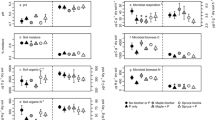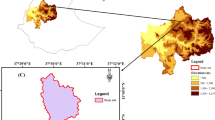Abstract
Red alder (Alnus rubra Bong.) stands in the Pacific Northwest are the common first stage in succession following disturbance. These stands are highly productive and contribute a large amount of N to the soils as a result of their N2-fixing symbiosis with Frankia. As these alder stands age, the soils not only increase in total N, but concentrations of NO− 3 increase and pH decreases as a result of nitrification. The objective of this study was to determine how the nodulation capacity of Frankia varies as red alder stands age and if differences in nodulation capacity are related to changes in soil properties. Nodulation capacity was determined by a red alder seedling bioassay for soils from red alder stands in the Oregon coast range covering a wide range of ages. Six chronosequences were sampled, each containing a young, an intermediate, and an older alder stand. Soil total N, total C, NO− 3, NH+ 4, and pH were measured on the same soil samples. These factors as well as alder stand characteristics were compared with nodulation capacity in an attempt to identify soil characteristics typical in developing alder stands that most strongly affect nodulation capacity. Soil pH and NO− 3 concentration were highly correlated with nodulation capacity and with each other. Cluster analysis of the sites using these two variables identified two groups with distinctly different nodulation capacities. The cluster with the higher nodulation capacity was lower in NO− 3 and higher in pH than the other cluster, which included the majority of sites. There was substantial overlap in the age ranges for the two clusters and there was no significant correlation between age and nodulation capacity. Thus nodulation capacity appears to be most closely related to soil properties than to stand age.
Similar content being viewed by others
References
Bormann B T, Cromack K and Russel W O 1994 Influences of red alder on soils and long-term ecosystem productivity. In The Biology and Management of Red Alder. Eds. D E Hibbs, D S De-Bell and R F Tarrant. pp. 47–56. Oregon State University Press, Corvallis, Oregon.
Carlton G C 1988 The structure and dynamics of red alder communities in the Central Coast Range of Western Oregon. M.S. Thesis. Oregon State University, Corvallis, Oregon.
Crannell WK and Myrold D D 1994 Calcium and pH interactions on root nodulation of nursery-grown red alder (Alnus rubra Bong.) seedlings by Frankia. Soil Biol. Biochem. 26, 607–614.
Griffiths A P and McCormick L H 1984 Effects of soil acidity on nodulation of Alnus glutinosa and viability of Frankia. Plant Soil 79, 429–434.
Hilger A B, Tanaka Y and Myrold D D 1991 Frankia inoculation increases yields of bare-root red alder in fumigated nursery soil. New Forests 5, 35–42.
Kohls S J and Baker D D 1989 Effects of substrate nitrate concentration on symbiotic nodule formation in symbiotic nodule formation in actinorhizal plants. Plant Soil 118, 171–179.
Martin K J, Tanaka Y and Myrold D D 1991 Peat carrier increases inoculation success with Frankia in red alder (Alnus rubra Bong.) in fumigated nursery beds. New Forests 5, 43–50.
Resch H 1979 Industrial uses and utilization potential for red alder In Symbiotic Nitrogen Fixation in theManagement of Temperate Forests. Eds. J C Gordon, C T Wheeler and D A Perry. pp. 444–450. Oregon State University, Corvallis, Oregon.
Sharma E and Ambasht R S 1988 Nitrogen accretion and its energetics in the Himalayan alder. Funct. Ecol. 229–235.
Smolander A and Sarsa M-L 1990 Frankia strains of soil under Betula pendula: behavior in soil and in pure culture. Plant Soil 122, 129–136.
Smolander A, van Dijk C and Sundman V 1988 Survival of Frankia strains introduced into soil. Plant Soil 106, 65–072.
Smolander A and Sundman V 1987 Frankia in acid soils of forests devoid of actinorhizal plants. Physiol. Plant. 70, 297–303.
Van Miegroet H and Cole D W 1985 Acidification sources in red alder and Douglas-fir soils - the importance of nitrification. Soil Sci. Soc. Am. J. 49, 1274–1279.
Zitzer S F and Dawson J 1992 Soil properties and actinorhizal vegetation influence nodulation of Alnus glutinosa and Elaeagnus augustifolia by Frankia. Plant Soil 140, 197–204.
Author information
Authors and Affiliations
Corresponding author
Rights and permissions
About this article
Cite this article
Martin, K.J., Posavatz, N.J. & Myrold, D.D. Nodulation potential of soils from red alder stands covering a wide age range. Plant and Soil 254, 187–192 (2003). https://doi.org/10.1023/A:1024955232386
Issue Date:
DOI: https://doi.org/10.1023/A:1024955232386




